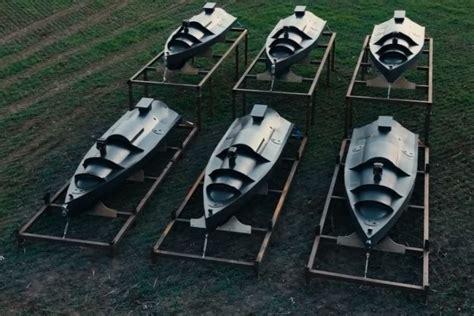
Ukraine Promised Drone Boat Fleet By Germany. It May Be Weapons Not Yet Seen.
Kamikaze sea drones, also known as USVs (Uncrewed Surface Vessels) have been one of Ukraine’s most successful innovations. Their crewed navy has played no role in this conflict; Ukraine’s only frigate, under repairs at the time of the invasion, was scuttled to prevent it being captured. But robot vessels have stepped in to fill the gap with impressive results, including attacking the Russian fleet in harbor. Now Germany is boosting Ukraine’s robot fleet with the promise of 50 new USVs, although there is no indication where these will come from.
A New Type of Naval Warfare
Russia ought to have complete naval dominance in the Black Sea, and in the first few months of the war its warships roamed freely, sailing close to Ukraine to unleash barrages of cruise missiles. But since last November they have been holed up in Sevastopol due to the threat posed by Ukrainian kamikaze USVs.
Russian ships are having trouble stopping the small, fast boats. Attack videos show them hurtling towards the target through a hail of gunfire and splashes in the water as defenders bring small-caliber automatic cannon to bear. And while most of the kamikazes are destroyed before they reach their targets, many get through. As Ukraine’s intelligence chief Kyrylo Budanov noted in a recent media interview: “They destroy 60%, maybe even 70%. This is true…the problem for them is the 30%.”
Earlier this month the drone boats scored hits on four Russian ships in three days. The strikes rarely result in a sinking, but images such as the Russian warship Samum being towed back to base show the attacks inflict real damage. And the action is entirely one-sided: the drone fleet repeatedly inflicts casualties on the Russian navy with zero casualties to Ukraine.
In August President Zelensky announced the formation of a new naval unit, the 385th Separate Brigade, which operates uncrewed systems. This is the first such naval drone unit in the world.
The evolution of drone boats in Ukraine has been astonishingly rapid. As HI Sutton notes in his guide to Ukraine’s maritime drones, six types have been observed so far, and there may be others not documented. These range from weaponized robot jet skis used to attack Sevastopol harbor to the largest Sea Baby drones, which put sections of the Kerch Bridge out of action. The Sea Babies reportedly carried 1,900-pound warheads, possibly a special design which directed the blast upwards to knock out the bridge spans from below.
While the U.S. has supplied some USVs to Ukraine, likely Mantas T-12s, the attack boats appear to be entirely of local manufacture from commercial engines and other components. Some appear sophisticated, such as the Magura V5 displayed at the IDEF 2023 expo in Turkey in July. The 18-foot Magura V5 has a claimed top speed of 42 knots (48 mph) with a 700-pound payload. The range of such drones is open to question. The Magura has a claimed range of around 500 miles, but some attacks appear to have been carried out at longer distances and it is not clear whether there are any safe spaces in the Black Sea.
Sea drones, made in Germany?
Now Ukraine’s USV fleet is getting a boost from Germany. In an international meeting at Ramstein Air Force base on Tuesday, Parliamentary State Secretary Siemtje Möller announced a new €400 million support package for the Ukrainian armed forces including anti-aircraft weapons and artillery ammunition.
“In addition, 50 surface drones are designed to help throw back the aggressor not only on land, but also at sea. The individual projects are realized through donations from Bundeswehr stocks as well as together with the industrial partners. The promised equipment is to be made available to Ukraine as soon as possible [Google GOOG -2.4% translation],” according to the official statement.
For some reason another official website gives the number of surface drones as 10. The big question is what type of USVs are involved.
The German navy acquired just one ARCIMS USV for an experimental minesweeper role back in 2016 from Atlas Electronik, and back in 2008 Rheinmetall Defence converted a boat to drone operation. Unlike the U.S. Navy, which has been very active in small USVs, the Bundeswehr does not have stocks of them, or obvious German industrial partners with suitable military drones which can be supplied by the dozen at short notice.
A new German defense paper laying out naval plans to 2035 indicates that there will be heavy investment in naval drones to supplement crewed vessels over the next decade, but this focuses on larger types to assist frigates rather than small kamikazes. Prior to this conflict, they simply were not considered a likely weapon for major navies, and more the province of insurgent groups like the Houthis.
Ukrainian industry has shown how rapidly they could develop new USVs from scratch with limited resources. They have done this even while under direct attack – in August Russia claimed to have wiped out Ukraine’s USV production and storage site with long-range missiles. This claim appears premature.
Germany, with its greater technical resources, may be planning to produce a completely new range of small USVs from a clean slate, customized to the needs of this conflict. This approach would also give Germany a head start in a technology which is increasingly being seen as the future of naval warfare.
Source » forbes.com





